Fahes Vehicle Inspection Report Qtar: Complete Guide
Fahes inspection reports are official documents issued after mandatory vehicle inspections in Qatar. These reports provide a detailed assessment of a vehicle’s safety, roadworthiness, and emissions compliance.
Understanding the Fahes inspection process and report for all vehicle owners in Qatar is crucial to ensure their vehicles meet required standards and can be legally driven on Qatar’s roads.
What is Fahes?
Fahes, short for “Facility for Inspection of Vehicles,” is the authorized body in Qatar responsible for conducting mandatory vehicle inspections. Established to enhance road safety and reduce environmental pollution, Fahes plays a vital role in maintaining the quality and safety of vehicles on Qatar’s roads.
The Purpose of Fahes Inspections
Fahes inspections serve several important purposes:
- Ensuring road safety
- Reducing vehicle-related accidents
- Minimizing environmental pollution
- Verifying vehicle compliance with Qatar’s traffic laws
- Maintaining the overall quality of vehicles on Qatar’s roads
Types of Fahes Inspections
Fahes conducts various types of inspections to cater to different vehicle needs:
- Periodic inspection
- Registration renewal inspection
- Transfer of ownership inspection
- Export certificate inspection
- Accident inspection
- Modified vehicle inspection
- Classic car inspection
The Fahes Inspection Process: Step-by-Step Guide
Understanding the Fahes inspection process can help vehicle owners prepare adequately and ensure a smooth experience. Here’s a detailed breakdown of the steps involved:
1. Book an Appointment Through Woqod App
To schedule a Fahes inspection:
- Download the WOQOD app.
- Login or signup.
- Tap “Fahes” option located under products and services.
- Click on the “Book Appointment” section
- Select your preferred inspection center
- Choose a suitable date and time
- Provide your vehicle details (make, model, year, plate number)
- Confirm your booking and note the appointment reference number
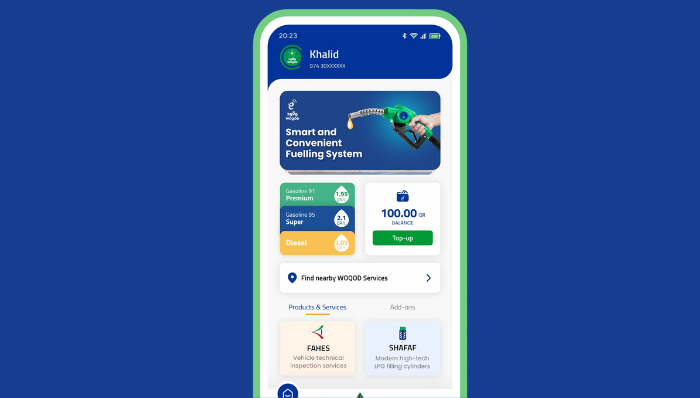
2. Prepare Your Vehicle
Before the inspection, ensure your vehicle is in the best possible condition:
- Wash and clean your vehicle thoroughly, inside and out
- Check and top up all fluids (engine oil, coolant, brake fluid, power steering fluid)
- Ensure tires are in good condition and properly inflated
- Test all lights and signals (headlights, taillights, indicators, brake lights)
- Address any known issues or warning lights on the dashboard
- Remove any unnecessary items from the vehicle
3. Gather Required Documents
Prepare the following documents:
- Vehicle registration card (Istimara)
- Qatar ID
- Proof of insurance
- Previous inspection report (if applicable)
- Authorization letter (if the owner is not present)
4. Arrive at the Inspection Center
On the day of inspection:
- Arrive at least 15 minutes before your scheduled appointment
- Park your vehicle in the designated waiting area
- Proceed to the reception and present your documents
- Pay the inspection fee
- Receive a queue number and wait for your turn
5. Go Thorugh The Inspection Procedure
During the inspection, Fahes technicians will thoroughly examine your vehicle:
- Vehicle identification and documentation verification
- Exterior condition assessment
- Undercarriage and suspension check
- Brake system evaluation
- Steering and alignment inspection
- Lights and electrical systems testing
- Emissions test
- Safety features examination
- Interior inspection
The inspection typically takes 30-45 minutes, depending on the vehicle type and condition.
6. Receive the Inspection Report
After the inspection:
- Wait for the technician to complete the report
- Collect your Fahes inspection report from the designated counter
- Review the report carefully with the technician
- Ask for clarification on any points you don’t understand
Decoding the Fahes Inspection Report
The Fahes inspection report is a comprehensive document that provides detailed information about your vehicle’s condition. Understanding this report is crucial for maintaining your vehicle and ensuring it meets Qatar’s road safety standards.
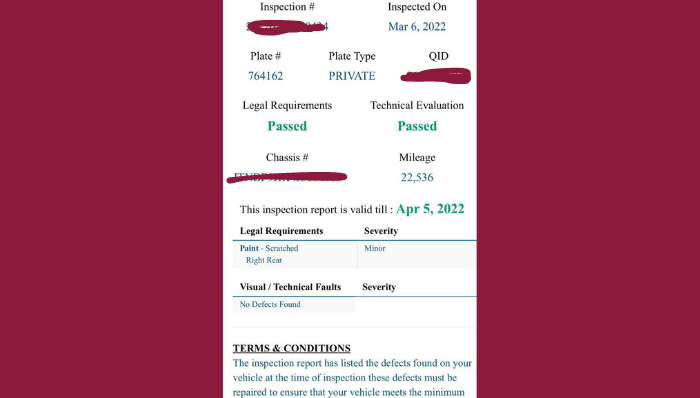
Components of the Fahes Inspection Report
A typical Fahes inspection report includes:
- Vehicle Information
- Make and model
- Year of manufacture
- Vehicle Identification Number (VIN)
- License plate number
- Odometer reading
- Inspection Details
- Date and time of inspection
- Inspection center location
- Technician ID
- Inspection Results
- Overall pass/fail status
- Detailed results for each inspection category
- Comments and recommendations from the technician
- Emissions Test Results
- CO, HC, and CO2 levels
- Comparison with acceptable limits
- Brake Efficiency Results
- Front and rear brake efficiency percentages
- Overall braking system evaluation
- Suspension and Alignment Results
- Wheel alignment measurements
- Suspension component condition
- Safety Features Evaluation
- Seatbelt condition and functionality
- Airbag system status (if applicable)
- Child safety lock functionality (if applicable)
- Additional Observations
- Any minor issues that don’t affect the overall result
- Recommendations for future maintenance
Interpreting Inspection Results
The Fahes inspection report will indicate one of three outcomes:
- Pass: Your vehicle meets all required standards and is fit for road use.
- Conditional Pass: Minor issues have been identified that need addressing within a specified timeframe (usually 30 days). You can continue to use your vehicle during this period but must rectify the issues and undergo a re-inspection.
- Fail: Major issues require immediate attention. Your vehicle is not considered roadworthy and must undergo repairs before a re-inspection.
How To check Fahes report online?
- Open your web browser and go to official Fahes website. (Here is the link)
- Click online report search. It is located in the header menu bar.
- On this page, you’ll see a form to enter your vehicle details.
- Enter the following information in the provided fields:
- Plate number
- Plate type (select from the dropdown menu)
- Your Qatar ID (QID) number
- After entering the required details, click on the “Search” button.
- Your Fahes inspection report will be displayed on the screen, showing all the details of your vehicle’s most recent inspection.
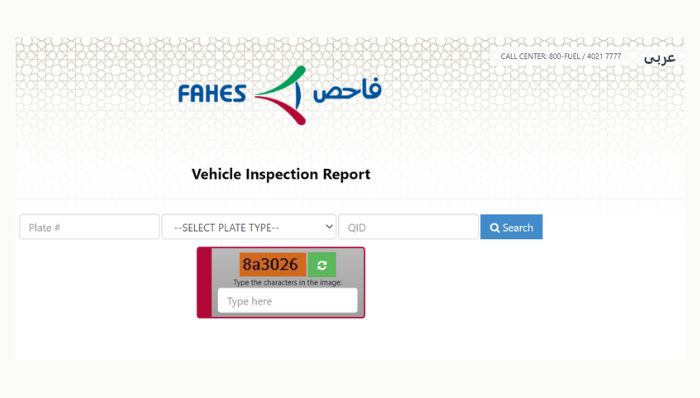
Important notes:
- Make sure you have your vehicle’s plate number and your QID number ready before starting the process.
- The online report is typically available shortly after your vehicle inspection is completed.
- If you can’t access your report, double-check that you’ve entered all information correctly.
- The inspection report is valid for 30 days from the date of inspection.
- If your vehicle fails the inspection, the report will indicate the reasons, which you’ll need to address before a re-inspection.
Common Reasons for Failing a Fahes Inspection
Understanding the most common reasons for failing a Fahes inspection can help vehicle owners take preventive measures. Here are the top reasons:
- Excessive Emissions
- High levels of CO, HC, or CO2 in exhaust gases
- Faulty catalytic converter
- Engine running rich or lean
- Faulty Brakes
- Worn brake pads or shoes
- Warped brake rotors
- Brake fluid leaks
- Imbalanced braking efficiency between front and rear
- Damaged or Worn Tires
- Insufficient tread depth
- Uneven wear patterns
- Visible damage (cuts, bulges, or exposed cords)
- Mismatched tires
- Non-functional Lights or Signals
- Burned-out bulbs
- Cracked or damaged lenses
- Misaligned headlights
- Faulty wiring
- Structural Damage or Excessive Rust
- Compromised frame integrity
- Rust holes in body panels
- Damaged or weakened suspension mounting points
- Leaking Fluids
- Engine oil leaks
- Coolant leaks
- Power steering fluid leaks
- Transmission fluid leaks
- Improper Tinting or Modifications
- Excessively dark window tint
- Unauthorized vehicle modifications
- Non-compliant aftermarket parts
- Suspension Issues
- Worn shock absorbers or struts
- Damaged or worn bushings
- Broken or weak springs
- Steering Problems
- Excessive play in steering wheel
- Power steering system faults
- Worn tie rods or ball joints
- Safety Equipment Failures
- Non-functional seatbelts
- Airbag system faults
- Defective windshield wipers
- Cracked or damaged windshield
What to Do If Your Vehicle Fails Inspection?
If your vehicle fails the Fahes inspection, don’t panic. Follow these steps to address the issues and get your vehicle back on the road:
- Review the Inspection Report Carefully
- Understand each failed item and its severity
- Note any recommendations provided by the technician
- Prioritize Repairs
- Address safety-critical issues first
- Plan for repairs based on urgency and cost
- Choose a Reputable Workshop
- Select an authorized service center or reputable garage
- Ensure they have experience with Fahes requirements
- Make Necessary Repairs
- Provide the workshop with a copy of your Fahes report
- Request a detailed quote for all required repairs
- Ensure all failed items are addressed
- Collect Repair Documentation
- Get itemized receipts for all repairs made
- Ask for a report detailing the work done
- Schedule a Re-inspection
- Book a re-inspection appointment through the Fahes website
- Choose a date that allows enough time for thorough repairs
- Prepare for Re-inspection
- Clean your vehicle thoroughly
- Gather all repair documentation
- Arrive early for your appointment
The Re-inspection Process
The re-inspection process is similar to the initial inspection but focuses on the previously failed areas:
- Present your original inspection report and repair documentation
- Pay the re-inspection fee (usually lower than the initial inspection fee)
- Your vehicle will undergo a targeted inspection of previously failed items
- If all issues are resolved, you’ll receive a pass result
- If any issues remain, you may need to repeat the repair and re-inspection process
Importance of Regular Maintenance
Regular vehicle maintenance is crucial not only for passing Fahes inspections but also for ensuring road safety, improving fuel efficiency, and prolonging your vehicle’s lifespan. Here are some essential maintenance tips:
- Follow Your Vehicle’s Maintenance Schedule
- Adhere to manufacturer-recommended service intervals
- Keep a log of all maintenance performed
- Address Issues Promptly
- Don’t ignore warning lights or unusual noises
- Small problems can escalate if left unattended
- Use Quality Parts and Fluids
- Opt for OEM or high-quality aftermarket parts
- Use the correct grade of oil and other fluids
- Keep Records of All Maintenance and Repairs
- Maintain a file with all service receipts and reports
- This documentation can be valuable for resale and troubleshooting
- Perform Regular Self-Inspections
- Check tire pressure and condition monthly
- Inspect lights and wipers regularly
- Monitor fluid levels between services
- Pay Attention to Your Vehicle’s Performance
- Note any changes in handling, braking, or acceleration
- Be aware of any new sounds, smells, or vibrations
- Keep Your Vehicle Clean
- Regular washing helps prevent rust and paint damage
- A clean interior can help you spot leaks or other issues early
Fahes Inspection Centers in Qatar
Qatar has several Fahes inspection centers located throughout the country to serve vehicle owners conveniently. Here’s a list of the main centers:
| Station Name | Location | Working Hours |
|---|---|---|
| FAHES Industrial Area | 24th St, الريان، Qatar | Sun – Thu: 6:00 AM – 5:45 PM Sat: 6:00 AM – 5:45 PM |
| FAHES Al-Wakrah | 5HVV+R8G, Al Wakrah, Qatar | Sun – Thu: 6:00 AM – 5:45 PM Sat: 6:00 AM – 5:45 PM |
| FAHES Wadi Al Banat | 9FHC+X39، Unnamed Road, Alnuaimi Area, Qatar | Sun – Thu: 6:00 AM – 5:30 PM |
| FAHES Al Mazrouah | Al Mazrouah, Qatar | Sat – Thu: 6:00 AM – 5:45 PM |
| FAHES Mesaimeer | 6GH6+G66, Doha, Qatar | Sun – Thu: 6:00 AM – 9:00 PM |
| FAHES Madinat Al Shamal | 4687+9R7, Madīnat ash Shamāl, Qatar | Wed-Thu: 7:00 AM – 2:00 AM |



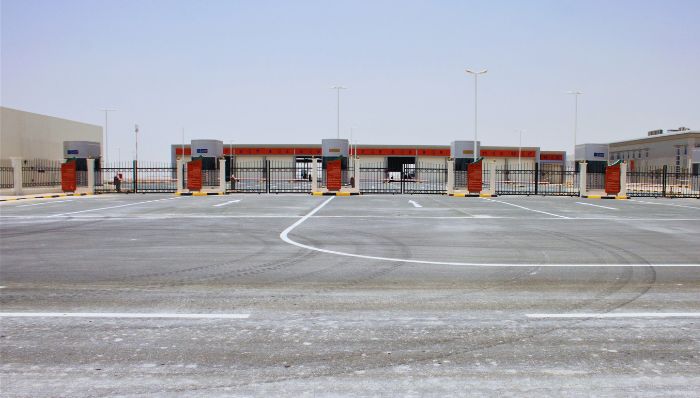
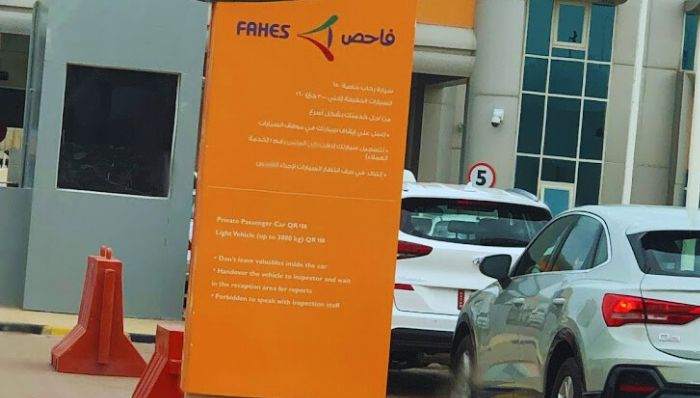

Choosing the Right Inspection Center
Consider these factors when selecting a Fahes inspection center:
- Location and Accessibility
- Choose a center that’s convenient to reach
- Consider traffic patterns and peak hours
- Wait Times and Appointment Availability
- Some centers may have shorter wait times or more available slots
- Check the Fahes website for real-time availability
- Services Offered
- Ensure the center caters to your vehicle type
- Some centers offer additional services like on-site repairs
- Customer Reviews and Ratings
- Check online reviews for insights on service quality
- Ask friends or colleagues about their experiences
- Facilities and Amenities
- Some centers have better waiting areas or on-site cafeterias
- Consider comfort if you expect a long wait
Fahes Inspection Fees
Fahes inspection fees vary depending on the type of vehicle and inspection required. Here’s a general overview of fees:
| Vehicle Category | Inspection Fee |
|---|---|
| Private Passenger Car | 150 QR |
| Light Vehicle (Taxi, Private & Public Transport <3000kg) | 160 QR |
| Heavy Vehicle (Private & Public Transport >3000kg) | 250 QR |
| Trailer/Semi Trailer | 300 QR |
| Heavy Equipment (Road Use and Non-Road Use) | 300 QR |
| Drinking Water Tanker | 500 QR |
| Tank Capacity Certificate | 300 QR |
| Motorcycle | 100 QR |
| Haj Bus | 550 QR |
| VIN Stamping (Heavy Vehicle Trailer) | 400 QR |
| VIN Marking (Heavy Vehicle Trailer) | 250 QR |
| Drinking Water Tanker (Re-Inspection) | 250 QR |
Payment Method: Card/Credit
Important Note: If a vehicle fails its first re-inspection, subsequent re-inspections will be charged at the standard main inspection rate. Within 30 days of the original main inspection, the pattern alternates between one paid and one free inspection. If a vehicle doesn’t pass within this 30-day period, all previous reports and repairs will be disregarded, and a new comprehensive main inspection will be conducted, reassessing all components.
Tips for a Smooth Fahes Inspection Experience
To ensure a hassle-free inspection process:
- Book your appointment in advance to avoid long wait times
- Arrive at least 15 minutes early to complete paperwork
- Bring all necessary documents, including your Qatar ID and vehicle registration
- Ensure your vehicle is clean, both inside and out
- Address any known issues before the inspection
- Be prepared to wait during the inspection process
- Ask questions if you’re unsure about any part of the process
- Keep a copy of your inspection report for your records
- If you fail, schedule repairs and re-inspection promptly
- Consider having a pre-inspection check at a trusted garage
Frequently Asked Questions
How often do I need a Fahes inspection?
The frequency of Fahes inspections depends on your vehicle’s age and type:
- New vehicles: Every 3 years
- Vehicles 3-6 years old: Every 2 years
- Vehicles over 6 years old: Annually
- Taxis and commercial vehicles: Every 6 months
Can I drive my vehicle if it fails the Fahes inspection?
If your vehicle fails the inspection, you may be given a grace period to make repairs. However, if the issues are severe, you may be prohibited from driving until repairs are made and the vehicle passes re-inspection.
How long does a Fahes inspection take?
A typical Fahes inspection takes about 30-45 minutes, but wait times can vary depending on the center and time of day. It’s best to allocate at least 2 hours for the entire process.
Can I get my vehicle repaired at the Fahes center if it fails?
Some Fahes centers offer on-site repair services for minor issues. However, for major repairs, you’ll need to visit an authorized workshop or your preferred mechanic.
What documents do I need for a Fahes inspection?
You’ll typically need:
- Vehicle registration card (Istimara)
- Qatar ID
- Proof of insurance
- Previous inspection report (if applicable)
- Authorization letter (if the owner is not present)
Can I transfer my vehicle’s ownership without a valid Fahes inspection?
No, a valid Fahes inspection is required for transferring vehicle ownership in Qatar. The inspection must be current and the vehicle must have passed.
Are there any exemptions from Fahes inspections?
Certain vehicles may be exempt from regular Fahes inspections, including:
- New vehicles (for the first three years)
- Diplomatic vehicles
- Military and police vehicles
- Some classic or vintage cars (subject to special regulations)
What happens if I miss my Fahes inspection deadline?
If you miss your inspection deadline, you may face fines and your vehicle registration may be suspended. It’s important to schedule your inspection before your current certificate expires.
Can I appeal a failed Fahes inspection result?
Yes, if you believe the inspection result is incorrect, you can file an appeal with Fahes. You’ll need to provide evidence to support your claim, and a senior technician will review your case.
Are there any special requirements for commercial vehicles?
Yes, commercial vehicles often have additional inspection requirements, including:
- More frequent inspections (usually every 6 months)
- Stricter emissions standards
- Additional safety equipment checks
How to print Fahes inspection report?
Fahes has moved away from issuing printed inspection reports and now sends results via SMS text message with a link to view the report online. However, you can still print the report if needed:
- You’ll receive an SMS with a link to the online report after inspection.
- Click the link to view the full report online.
- Use your device’s print function to print the online report.
- If you don’t have a smartphone, Fahes centers have help desks where you can request a printed report.
- Some photo studios and typing centers also offer printing services for Fahes reports for around QR5 per report.
How much is Fahes inspection?
The cost of Fahes inspection varies depending on the type of vehicle:
- Private Passenger Car: QR 150
- Light Vehicle (Taxi, Private & Public Transport less than 3000kg): QR 160
- Motorcycle: QR 100
- Heavy Vehicle (Private & Public Transport of more than 3000kg): QR 250
- Trailer, Semi Trailer, Heavy Equipment (For and Not For Road Use): QR 300

Ammara Abdullah is an experienced writer and editor specializing in technology and digital trends. With over 5 years of experience, she produces insightful articles on emerging tech, consumer electronics, and digital culture. Ammara holds a degree in journalism and is passionate about making complex topics accessible to readers.






